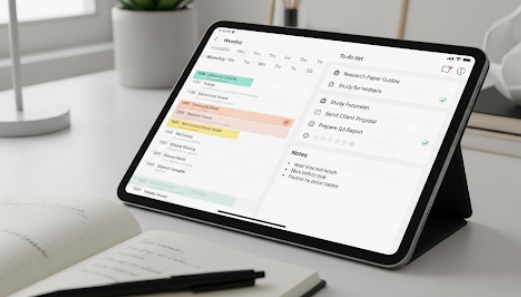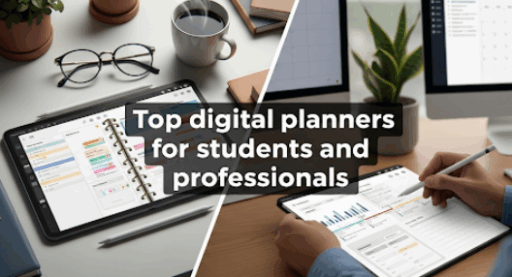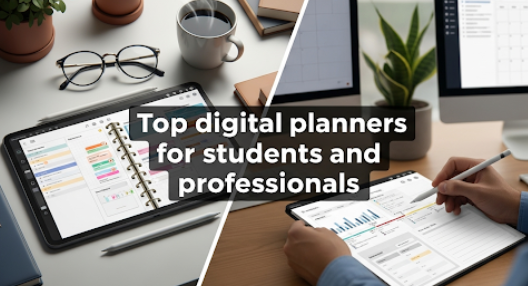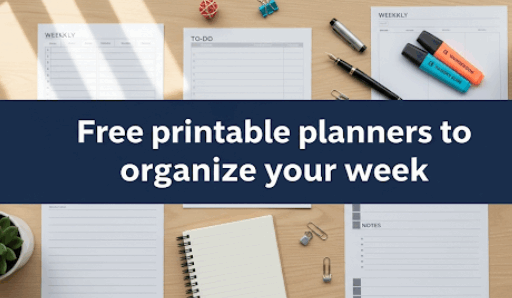The Ultimate Guide to Get You Organized in 2025 — Best Digital Planner for Students and Working Professionals
Remember when you had to lug around a big paper planner that got lost in the bottom of your backpack or briefcase? Now, digital planners are the new game changers — they keep your life within reach in a smart way and sync across all of your devices to ensure nothing falls through the cracks. So if you have a million and one things to do like the average high school student who has multiple classes a day and also does sports, or you are just over the age of 18 and have adult stuff to handle, then finding an online planner can really help keep you on track.
We are going to take a look at today’s top digital planning tools, their features and help you find the almost perfect tool – just read on through this extensive guide! We offer no-cost and premium reviews of the best UX, UI and conversion tools available today.
Digital Planners are Better Than Traditional Paper Planners
There are things that digital planners can do that a washi tape-heavy-paper planner just can’t replicate. Millions of people have switched for a reason.
Instant Accessibility On Any Device
Your digital planner exists on your cell phone, computer and tablet. So you can view your calendar, schedule appointments or add tasks from everywhere. Left your paper planner at home? With digital solutions this is never an issue.
Smart Reminders & Notifications
A digital planning tool will be able to send you a notification before important deadlines, remind you of upcoming meetings or even nudge you when it’s time to start working on a project. You get automatic reminders so you don’t have those “Oh no, I forgot!” moments.
Simple Share and Collaborate
Instead of struggling in groups to develop a project or family schedules, sharing calendars and task lists is straightforward. Collaboration is made easy and efficient because the team will see updates real-time.
Searchable and Organized
Looking for that meeting you booked 3 months ago? Just search for it. With a digital planner it is simple to find any information instantly, unlike flipping through a paper planner.
Good For The Environment
No purchasing new planners every year and no wasted paper. Digital planning is sustainable and cheap.
Best Digital Planners for Students
Notion – The All-in-One Student Workspace
Price: Free for individuals, paid plans from $8/month
Students LOVE Notion because it is the Swiss Army knife of productivity! It is everything rolled into one: the place where you write stuff down, manage your todos, plan all of your calendars and manage databases.
Key Features for Students:
- Built-in library with ready student planner templates
- Class schedule tracking with color-coding
- Assignment deadlines with automatic reminders
- Note-taking with rich formatting options
- Grade tracking and GPA calculators
- Study session planning with time-blocks
Pros:
- Entirely customizable to how you study
- Ideal for visual learners as it uses drag-and-drop interface
- Great capabilities for group projects and teamwork
- Works offline (with limitations)
- The free version has most of the features students would need
Cons:
- Can be overwhelming for beginners
- Time investment required to set up
- Slower than desktop version on mobile app
Good for: Students who have a lot of features that they need out of their planning system and don’t mind investing some time to customize and set up.
Google Calendar — Straightforward & Dependable
Price: Free
Because it’s simple, dependable, and integrates well with the rest of Google’s services — and for many students, Google Calendar is still the best option out there.
Key Features for Students:
- Support multiple calendars (personal, school, work)
- Natural Language Processing for Event Creation
- Automatic time zone adjustments
- Automatically imports events from your existing Gmail
- Mobile app with offline access
- Sharing capabilities for study groups
Pros:
- Completely free with Google account
- Available on any device with internet connection
- Intuitive User Interface that’s easier to learn
- Reliable notifications and reminders
- Simple integration with school email systems
Cons:
- Limited task management features
- No built-in note-taking capabilities
- Basic customization options
- Requires Google account
Great For: Students who are looking for a straightforward, no-frills calendar solution that is just reliable.
Microsoft To Do: Ideal for Office 365 Subscribers
Price: Free
If your school is powered by Microsoft Office 365, Microsoft To Do offers a great experience and should fit in smoothly with your workflow.
Key Features for Students:
- Automated Task Organization with Smart Lists
- Due date tracking with color-coded urgencies
- File attachments from OneDrive
- Integration with Outlook calendar
- Shared lists for group projects
- Daily planning suggestions
Pros:
- Free with Microsoft account
- Seamless integration with Office 365
- Clean, intuitive interface
- Great collaboration features
- Works across all platforms
Cons:
- Limited calendar view options
- Fewer customization features than competitors
- Full advantage needs Microsoft ecosystem
Best for: Students who are already using Microsoft Office 365, and want their planner to play nice with all of their school tools.
Top Digital Planners for Professionals
Asana – Project Management Powerhouse
Price: Free for 15 team members, from $10.99 per month
Asana is much better when it comes to being able to help business professionals manage their complex projects and involve team members in an efficient collaboration environment.
Key Features for Professionals:
- Different project views: list, board, timeline, calendar
- Task dependencies and milestone tracking
- Team collaboration via comments and proofs
- Custom fields and project templates
- Time tracking integrations
- Advanced reporting and analytics
Pros:
- Excellent for team collaboration
- Highly customizable workflow options
- Robust project management features
- Great mobile apps
- Strong integration ecosystem
Cons:
- May be over-engineering for basic personal plans
- Learning curve for advanced features
- Free version with limitations on larger teams
Ideal For: Professionals who oversee multiple projects and collaborate extensively with a team.
Todoist – Task Management Winner
Price: Free version available / paid plans begin at $4/month
Todoist is all about keeping task management as simple and useful as it can be without getting bloated with features.
Key Features for Professionals:
- Natural language date recognition
- Project templates and labels
- Karma system for motivation
- Smart scheduling suggestions
- Email integration for task creation
- Productivity tracking and insights
Pros:
- Nice and easy to use, intuitive interface
- Excellent natural language processing
- Great offline functionality
- Strong habit-building features
- Affordable premium pricing
Cons:
- Limited calendar integration
- No built-in time tracking
- Fewer collaboration features than competitors
Who it’s best for: Professionals who place a premium on task management over calendar scheduling and seek a streamlined, fast system.
Monday.com – Visual Project Tracking
Cost: At $8/month/person on paid plans
Monday.com has embraced visual project management that is rich and easy on the eyes.
Key Features for Professionals:
- Colorful, visual project boards
- Customizable workflows and automation
- Time tracking and resource management
- Advanced reporting dashboards
- Guest access for external collaborators
- Integration with 200+ apps
Pros:
- Highly visual and engaging interface
- Powerful automation capabilities
- Excellent for team transparency
- Flexible customization options
- Strong customer support
Cons:
- No free version available
- Can be costly with larger teams
- Learning curve for complex features
Ideal for: Professional teams who need visual project management and robust collaboration features.
Digital Planners Comparison Table
| Platform | Price | Best For | Ease of Use | Collaboration |
|---|---|---|---|---|
| Notion | Free/Premium | Students & Creatives | Good | Limited |
| Google Calendar | Free | All | Excellent | Basic |
| Microsoft To Do | Free | Office 365 Users | Average | Yes |
| Asana | Free/Premium | Project Teams | Excellent | Limited |
| Todoist | Free/Premium | Task-focused users | Excellent | Yes |
| Monday.com | Paid | Visual Teams | Good | No |
Picking The Right Digital Planner
There are dozens, if not hundreds of digital planners available and the best one to choose for you depends on your individual circumstances.
Consider Your Primary Use Case
Academic Success: If you’re a student, search for planners that manage class schedules and assignment tracking in addition to study planning. Group projects cannot work without grade tracking, semester planning, and collaboration tools.
Career Advancement: For working professionals, there will be planners that allow you to manage your projects, collaborate with team and keep track of deadlines. At that stage, integration with work tools and advanced analytics features will start to matter more.
Evaluate Your Tech Comfort Level
Beginners Should Choose:
- Straightforward interfaces with minimal learning curves
- Templates and Setup Walkthroughs
- Good customer support and help resources
- Popular options that have a considerable number of users
Tech-Savvy Users Can Handle:
- Complex customization options
- Advanced automation features
- Integration setup with multiple tools
- Beta features and newer platforms
Think About Your Team Needs
Personal Planning: Focus on personal productivity-oriented features, ease of use, cross-platform sync. You probably don’t need collaboration premium features.
Team Planning: Facilitate team collaboration by allowing different members to share, update in real-time, possess permission management over features relevant to the planning tool and communicate with each other.
Budget Considerations
Most digital planners provide free versions with limited functionalities. Begin gradually with the free options to evaluate the functionality before you proceed to premium plans. Think about it in the long run vs buying paper planners yearly.

How to Set Up Your Digital Planner For Success
After you’ve selected your digital planner, the real key to getting the most out of them is in the set-up!
Start with Basic Information
Personal Details:
- Include your basic schedule (when you are working, in class, when you make dinner every night…)
- Adjust your timezone and work hours as per your preference
- Set up notifications for various types of activity
Import Existing Data:
- Write down the vital dates from your old planner
- Import contacts & calendars if you can from Gmail
- Add recurring events and appointments
Create Your Organization System
Categories and Labels: Create a consistent way of categorizing your tasks and events with tags. Common categories include:
- Work/School projects
- Personal tasks
- Health and fitness
- Social events
- Financial planning
Priority Levels: Create a framework to systematically determine when a task is marked as high, normal or low priority. This gets you to your “true north,” essentially what really matters when things get busy.
Build Productive Habits
Daily Review: Spend 5–10 minutes each morning reviewing your plan and your priorities. A small cost that will keep you on track during the day.
Weekly Planning: Allot some time — perhaps weekly — to plan out your next steps, double-check what you have done and make necessary changes in the objectives. With this, you do not miss out on crucial work items.
Monthly Check-in: It’s crucial to have a time set aside once monthly to look over your system, what’s working and maybe where you still need some fine-tuning. Digital planners allow you to pivot as needed, using data and your experience to determine what is working best for you.
Advanced Tips for Power Users
Automation and Integration
Integrate Your Tools: The digital planner you choose should incorporate email, cloud storage, communication apps and other productivity tools. By creating these connections, it saves users time and cuts down on manual data entry work.
Smart Notifications: Be strategic with your notifications and only send them when it is necessary. Enable notifications only for deadlines of extreme importance while restricting distractions for minor tasks.
Creating Templates: Make templates for recurring projects, weekly calendars or monthly targets. Templates will save you time and keep your planning consistent!
Data Analysis and Improvement
Track Your Productivity: Some digital planners are equipped with information on your productivity tendencies, meaning how many tasks you complete and the time you allocate to them. Take advantage of this data to find ways in which you can improve.
Habit Tracking: Employ your planner’s tracker functionality to boost good habits. Whether it’s gym attendance, reading logs, or professional growth, monitoring these statistics helps you stay accountable.
Goal Achievement: Set up your planner so you can identify larger goals, then break them down into actionable tasks that are actually doable, and give them deadlines.
Troubleshooting Common Issues
Sync Problems
If you are having issues with your planner not syncing correctly across all devices:
- Check your internet connection
- Make sure you are on the same account across every device
- Update the Apps to Latest Version
- Clear the cache and restart these applications
Notification Overload
When notifications become overwhelming:
- Review and adjust notification settings
- Turn off non-essential alerts
- Put your phone and laptop on “Do Not Disturb” mode for certain periods of the day
- Combine similar notifications into daily or weekly summaries
Adoption Challenges
Problems you run into when it comes to using your digital planner consistently:
- Don’t use everything, start with one or two features
- Establish habits and routines automatically
- Get a buddy or join user groups
- Allow time to adapt to the new approach
The Future of Digital Planning
Digital planning evolves as new technologies come on the scene, or user needs change. Here are trends to watch:
AI Integration: AI has been a part of modern scheduling applications for some time now, often providing smart scheduling suggestions, automatic task prioritization and even predictive planning based on your past behavior and habits.
Voice Integration: Voice assistants that allow you to add tasks and events without using your hands are extremely helpful for people with hectic schedules such as professionals and students.
Enhanced Mobile: Mobile apps are more robust, offering capabilities previously reserved for desktop experience.
Enhanced Collaboration: Updates to live collaboration functionality makes it simple for teams to work together across geographies and time zones.
Your Plan to Transition
Ready to embrace digital planning? Here’s your step-by-step action plan:
- Choose Your Tool: From this guide, choose a couple of digital planners to experiment with to see which works best for you
- Start Small: First build basic functionality and work toward more advanced features
- Import Your Data: Move relevant data from your current planning system
- Set Up Notifications: Understand what alerts can be useful without annoying you
- Create Templates: Create reusable formats for frequent tasks or projects
- Commit to the Process: Use that fancy new planner daily (for at least two weeks!)
- Test and Tweak: Balance your system to what is most effective for you
The Beginning Of Your Path to Better Organization
Digital planners have bid adieu to the traditional pen and paper, and provide you with enhanced accessibility and dynamic features that evolve as your requirements change. As a professional dealing with multiple projects and deliverables, or a student who is managing assignments as well as extracurricular activities, digital planning solutions can effectively change how you organize your life.
Success is not only obtained in selecting the proper tool, but also in faithfully using it for a sufficient period to tailor it to your existing workflow. Choose one of the best planners from this list, try its functionalities and start a journey to create a system that will work for you in achieving your goals and dreams.
Note: The key to the best digital planner is the one that you’ll actually use daily. Don’t worry yourself trying to find the perfect solution — pick a good one and get started. Many allow you to switch or upgrade later as your needs change.
Your more organized, productive future starts here. Get started today and see how a digital planner can be the answer to reaching your goals in an easier and more successful manner!




